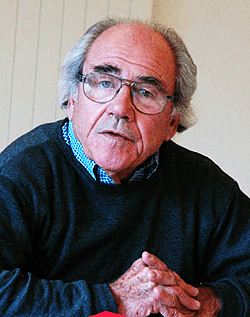Jean Baudrillard facts for kids
Quick facts for kids
Jean Baudrillard
|
|
|---|---|

Baudrillard in 2004 at the European Graduate School
|
|
| Born | 27 July 1929 Reims, France
|
| Died | 6 March 2007 (aged 77) Paris, France
|
| Alma mater | University of Paris |
| Era | 20th-/21st-century philosophy |
| Region | Western philosophy |
| School |
|
| Institutions |
|
| Thesis | Le système des objets (1968) |
| Doctoral advisor | Henri Lefebvre |
|
Main interests
|
|
|
Notable ideas
|
|
|
Influences
|
|
|
Influenced
|
|
Jean Baudrillard (born July 27, 1929 – died March 6, 2007) was a French sociologist, philosopher, and poet. He was very interested in cultural studies. He is famous for his ideas about media, modern culture, and how technology helps us communicate. He also created the idea of hyperreality. Baudrillard wrote about many different topics. These included consumerism, social history, aesthetics (the study of beauty), and popular culture.
Contents
Jean Baudrillard's Life Story
Jean Baudrillard was born in Reims, France, on July 27, 1929. His grandparents were farm workers, and his father was a police officer. When he was in high school, he learned about a way of thinking called pataphysics. This idea was important for his later work.
He was the first in his family to go to university. He moved to Paris to study at the Sorbonne. There, he studied German language and literature. From 1960 to 1966, he taught German at different high schools.
His Career as a Teacher and Thinker
While teaching, Baudrillard started writing reviews of books. He also translated works by famous writers like Karl Marx.
He slowly moved from teaching German to studying sociology. In 1968, he finished his main university paper, called Le Système des Objets (The System of Objects). His teachers for this paper included Henri Lefebvre and Roland Barthes. After this, he began teaching sociology at Paris X Nanterre. This university was very involved in the student protests of May 1968.
Baudrillard became an Assistant Professor and later a full Professor. He continued to develop his ideas.
In 1970, Baudrillard visited the United States for the first time. In 1973, he made his first trip to Kyoto, Japan. He received his first camera in Japan in 1981. This led him to become a photographer.
In 1986, he moved to another part of the University of Paris. He spent the rest of his teaching career there. Over time, he started to move away from traditional sociology. He didn't always identify with one specific field of study.
During the 1980s and 1990s, his books became very popular. He became a well-known thinker, and his work was often discussed in newspapers. He also taught at the European Graduate School in Switzerland.
In 1999–2000, his photographs were shown in an exhibition in Paris. In 2004, a big conference was held about his work in Germany.
Jean Baudrillard's Personal Life
Baudrillard enjoyed baroque music, especially the composer Claudio Monteverdi. He also liked rock music, such as The Velvet Underground & Nico.
He preferred to write using his old typewriter, not a computer. He felt a "physical relation to writing" with a typewriter.
Baudrillard was married twice. With his first wife, Lucile, he had two children, Gilles and Anne. In 1970, he met Marine Dupuis, who was 25. They married in 1994.
Jean Baudrillard was diagnosed with cancer in 2005. He passed away on March 6, 2007, at the age of 77. His wife, Marine Baudrillard, now manages an association for his friends called Cool Memories.
Jean Baudrillard's Main Ideas
Baudrillard was part of a group of French thinkers from his time. These included Michel Foucault and Jacques Derrida. They were all interested in semiotics, which is the study of signs and symbols.
How Objects Get Value

In his early books, Baudrillard focused on consumerism. He looked at how different objects are bought and used in different ways. At first, his ideas were similar to Marxism. However, he disagreed with Karl Marx on one important point. Baudrillard believed that consumption (buying things) was more important than production (making things) in a capitalist society.
He thought that our "needs" for things are not natural. Instead, they are created by society. He said that objects always "say something" about the people who use them. This is why consumption is so important: the idea of needing something comes before the product is even made.
He explained that an object can have value in four ways:
- The functional value: This is what an object is used for. For example, a pen writes, and a refrigerator keeps food cold.
- The exchange value: This is an object's economic worth. For example, one pen might be worth three pencils.
- The symbolic value: This is the meaning an object has between people. For example, a pen could be a gift for graduating. A diamond ring might show love between two people.
- The sign value: This is an object's value compared to other objects in a system. For example, a fancy pen might show high status, even if it writes the same as a cheap one. A diamond ring might not have a use, but it shows a certain social class or taste.
Baudrillard argued that the symbolic and sign values often change how we see the functional and exchange values. He later moved away from Marxist ideas completely. However, he continued to focus on the difference between sign value (related to buying and selling) and symbolic value (related to giving gifts).
Simulacra and Simulation
As Baudrillard's work grew, he started looking at media and mass communication. He was interested in how communication shapes our social relationships.
Baudrillard said that we live in a time of "simulation." This means that everything is made of references that don't have a real original. He called this hyperreality. He believed this was a historical process.
- In the past, like the Renaissance, copies were made to look like something real, even if the real thing didn't exist.
- During the Industrial Revolution, products were made on assembly lines. They could be copied endlessly.
- Today, the main form of copying is the "model." A model is already designed to be copied many times. It doesn't even need an original.
This means that the difference between what is real and what is fake has become blurry.
The End of History and Meaning
Baudrillard often wrote about history. He looked at how societies use ideas of progress and modernity in their choices. He believed that the idea of historical progress was collapsing.
For Baudrillard, the end of the Cold War didn't mean one side won. Instead, it meant that big ideas about the future, shared by both political sides, were disappearing. He thought that in a world of fast electronic communication, this collapse was unavoidable.
He argued that the speed of modern society had broken the straight line of history. He said that we have "smashed the referential orbit of things once and for all."
Baudrillard believed that even though people no longer truly believed in a universal end to history, the idea of "universal values" was still used. These values were used to justify actions that might otherwise seem wrong. He felt that the ways to act were still there, but the reasons for acting were gone. This was used to hide the difficult realities of the present.
See also
 In Spanish: Jean Baudrillard para niños
In Spanish: Jean Baudrillard para niños
- Hyper-real Religion
- Reza Negarestani
- The Real
- Code (semiotics)
- Psychoanalytic sociology


